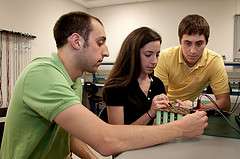Satellite battery could put Nittany Lion paw print in space

(Phys.org) -- On Feb. 3, 2006, astronauts tossed an old spacesuit off the International Space Station. Inside was a transmitter, a temperature sensor and some batteries.
The suit was a DIY satellite. It circled the Earth twice, repeating a greeting recorded in multiple languages; ham radio operators listened in as it passed overhead.
Then the batteries died.
The Radio Amateur Satellite Corporation, or AMSAT, tried again in 2011. The battery in that satellite, a more traditional box design, also failed.
For the next model, AMSAT, a volunteer group, turned to the School of Engineering at Penn State Erie, The Behrend College. Three students designed a brand-new battery: a four-pound cube powered by 15 supercapacitors, each roughly the size of a film canister.
The battery was built to handle 16 charge cycles in a 24-hour period. That will power the satellite in dark orbits, when the larger kit’s solar panels are not facing the sun.
To activate the battery before those solar panels charge, the students – David Jesberger, of St. Marys; Kathleen Nicholas, of Pittsburgh; and Jacob Sherk, of Elizabethtown – added four 9-volt Duracells.
AMSAT hopes to fit the satellite into a rocket payload and onto the International Space Station sometime in 2013. The astronauts won’t have to do much with it.
“It’s simple by design. They flip a switch, and they throw it out,” said Dakshina Murthy Bellur, an assistant professor of electrical and computer engineering at Penn State Behrend. He supervised the battery work, which counted as the students’ senior capstone project.
All three students have since graduated. All three have jobs: Nicholas and Jesberger signed on with defense contractors, and Sherk works at the Three Mile Island nuclear power plant.
They continue to track the AMSAT project. They want to know when their battery, upon which they laser-etched with their names and a Nittany Lion paw print, gets a launch date.
“That’s going to be cool,” Jesberger said. “We’ll have our signatures in space.”
Provided by Pennsylvania State University



















